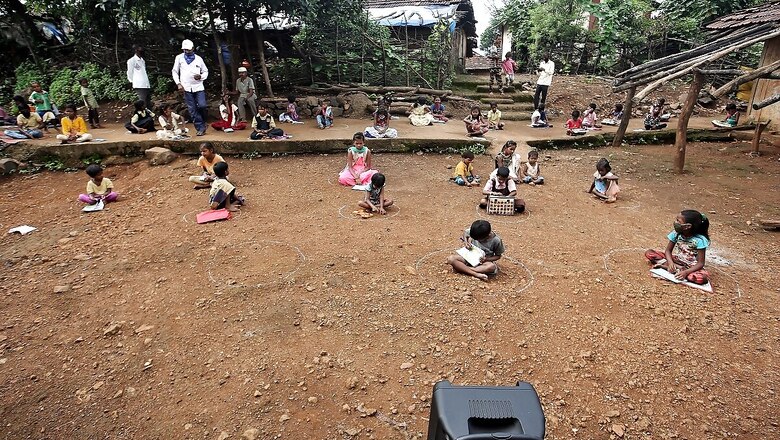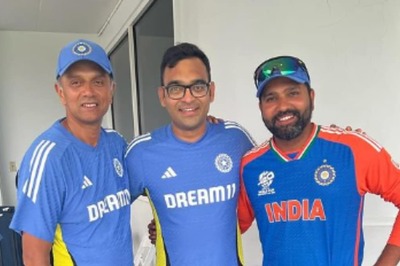
views
In September 1918, a physician stationed at Camp Devens, a military base west of Boston during World War I, penned a letter to his friend describing the horrifying conditions of American soldiers suffering from Spanish Flu. He wrote, "These men (soldiers) start with what appears to be an attack of la grippe or influenza, and when brought to the hospital they very rapidly develop the most vicious type of pneumonia that has ever been seen. Two hours after admission they have the mahogany spots over the cheekbones, and a few hours later you can begin to see the cyanosis extending from their ears and spreading all over the face until it is hard to distinguish the colored men from the white. It is only a matter of a few hours then until death comes, and it is simply a struggle for air until they suffocate. It is horrible."
At the time he wrote this letter, the United States of America was already battling the second wave of influenza, which eventually killed almost 50 million people and infected about one-third of the world population. However, governments of all belligerent countries, engaged in the world war I (including the US) suppressed the news of the rapid spread of the virus, so that the morale of the public is not dampened in the face of the ongoing war. Most countries imposed strict media censorship on publishing anything related to the flu, and it wasn't until cases of influenza began appearing in Spain, a neutral country in WWI, that reports of the flu pandemic became common knowledge, and the outbreak eventually got its name, 'Spanish Flu.' Circa 2020, such a colossal lag in information flow is an impossibility in our world today, thanks to the internet, an interconnected global computer network, that has spread its tentacles in the remotest parts of the world and has single-handedly connected 4.5 billion people so far.
At the onset of the Coronavirus outbreak in November 2019, despite the best efforts of the Chinese government to hide the truth about the spreading virus, and the initial under-reporting of death tolls, news of overflowing hospitals corridors with patients, harrowing personal accounts of combating the disease, stories of lives lost to the virus trickled in through the internet. As the Chinese government propelled the carefully curated heroism of doctors and nurses tackling the disease, netizens of the country raged against government officials over cover-ups, made memes, and criticized them vehemently on social media platforms. An effort to censor such online criticism only goaded them to find more innovative ways to condemn the government.
"The biggest differentiating factor between the past pandemics and the coronavirus pandemic is the availability of information about the disease, how it transmits, where is the origin of the outbreak, what are the precautions etcetera -- that the internet is easily providing," said Professor Tirthankar Roy, from the Department of Economic History, London School of Economics and Political Science (LSE). "If you read the historical works of 1918, you would find that people were largely ignorant about the causes, and precautions of the flu. I think that has changed with the advent of the internet, there is a lot of information that the public can access now," said Professor Roy.
Ignorance also fuelled many misinformation and superstitions back in the day. During the Spanish flu, for instance, parents would take their kids to the nearest industrial plant so that they can inhale the fumes, which they thought would keep the flu away. Another common treatment of Spanish Flu was bloodletting, which killed many people, rather than saving them. Among many other bizarre flu remedies that were popular during the time, was the notion that the color red can actually prevent the flu because the flu doesn't like the color.
Such widespread misconceptions had been fewer during the current pandemic, however, professor Roy pointed out that a steady stream of disinformation and misinformation has been flowing online. According to an analysis by BCC's Reality Check team, "as more Muslims tested positive, false claims about Muslims deliberately spreading the virus became viral." At the beginning of the lockdown phase, misinformation about meat and eggs connected to COVID-19 spread widely, due to which many people stopped eating poultry, which resulted in a massive drop in poultry sales.
However, the information overload that the internet provides these days is still less problematic than no information or limited information that people had to live with prior to the advent of the internet, as they navigated through a similar health crisis. While there is an urgent need to tease out misinformation and disinformation from the realms of the world wide web, there is no denying that the internet has truly been our savior during this pandemic. "The mortality rates are lower in this pandemic because we can work from home, thanks to the internet. Some of us, of course, not all can do that. During previous pandemics, even when a lockdown was imposed, it mostly applied to foreigners, migrants, and travelers. Domestically, people would go out to work which increased their risk of exposure to the virus, and caused many more deaths," added Roy.
The internet has also been our only connection to the outside world during the lockdown, helping us to keep tabs on our aging parents, reach out to our friends, and viewing the world through social media. Even weddings and funerals have happened online recently. And, it has been our biggest provider of entertainment. The last time India witnessed a pandemic of this scale, was in 1918, and back then, the options of entertainment were very limited. Cinema was still a very new concept and unaffordable for most. However, for us multiplex going, and IPL watching crowd, life would perhaps be unbearable in the absence of Netflix, and Amazon Prime Video, during these months of staying confined in our own homes.
The Internet arrived in India as a modest academic network launched by ERNET in 1986 and later, Videsh Sanchar Nigam Limited (VSNL) opened it up for public access on August 15, 1995. Since then, the internet infrastructure has grown strong rapidly, it has planted its arteries and veins in various corners of India. According to a report published by the Internet and Mobile Association of India in 2019, India has almost 451 million monthly active internet users. However, with the internet penetration of only 36 percent, there is a vast opportunity for internet infrastructure to grow. Subhagata Mukherjee, Leader for Nokia - Innovation and Technology Content & Office of the President, Nokia Bell Labs told News18, "India is still within the first 25 years of the internet percolation within the population, and it has done a fantastic job in bringing this critical infrastructure to its population, particularly access to mobile broadband."
"Unfortunately, until now, what we have digitalized are sectors that were easy to digitize like entertainment, media, and information technology. And, the internet was also being accessed by a section of the population for whom it was easier to gain access (such as the urban, semi-urban, middle to upper section of society). But, this pandemic has taught us how vastly insufficient this is, for the future. There is a need to accelerate our journey towards creating new high-quality internet infrastructure so that accessibility can be universal, and the internet can be used for economic productivity and in many other sectors which don't utilize its full potential" said Mukherjee.
So far, we have digitalized entertainment and shopping for people who need and can afford that, and digitalized the banking sector, which has been of great help to a large number of people. However, India now needs to focus on creating the internet that would help the productivity of its economy. Think about a migrant laborer in current circumstances, how can we use the internet to give him a job exchange opportunity? How can the internet be effectively used to teach a young girl in rural India how to write? How can we make effective telemedicine, and teleconsultation available to those patients in far-flung villages? --these are the questions that we now need to think about, in the light of the current pandemic.
"Where we are significantly falling behind is the economic impact of the internet. Very few small and medium scale industries and even large scale industries in the so-called "physical" sectors are actually using the internet for their business operations, other than probably just having an online presence. To impact the productivity growth of a country the internet has to impact these kinds of businesses, which form the largest portion of the economy. They also provide employment to many, and this pandemic has shown us how important a tool internet can be for these small enterprises" Mukherjee added. "The popular perception is that people in the manufacturing sector cannot do remote work. But, we have to ask, why not? This is exactly the opportunity that technology is providing us, the remote connectivity, not just between humans, but also between humans and machines, and humans and services. 5G, for instance, is mainly for industrial internet, it will be able to give remote connectivity to a factory worker so that he or she can move a lathe machine in a factory in a different state, from his home. These are not tales of science fiction, it is actually happening in other parts of the world where 5G network has already been established," pointed out Mukherjee.
Two of the most significantly affected sectors during this pandemic, healthcare, and education, fell back on the internet as an essential tool to keep them afloat. However, while we have seen considerable digitization of the healthcare sector in the past few months, the education sector is currently struggling to cope with the drastic changes that online teaching demands.
In the healthcare sector, Tele-consultancy, which is consulting a doctor through the internet has boomed in the past few months of COVID-19 induced lockdown, when everyone was afraid to go to the clinic or hospital due to the increased risk of contracting the virus. "A large part of our population lives in rural areas who require the same access to healthcare as we all do, which makes tele-consultancy a much-needed practice in healthcare," pointed out Dr. Alexander Kuruvilla, Chief Health Strategy Officer, Practo.
"ISRO has constantly reached out to support tele consultancy, and have offered teleconsultation for free. But, moving forward, if ISRO along with the government can give the last mile technology to every village in India, and equip primary healthcare centers for tele-consultancy, by cordoning off small areas in those primary healthcare facilities for tele consultancy, the process might work very well in future too," added Kuruvilla. Dr. Kuruvilla pointed out that it would not only save time but also be far more financially viable, given that Indian patients never travel alone for treatment, which means they have to spend a considerable amount of money on the conveyance alone.
Digitization of the healthcare sector can actually help healthcare professionals to predict and warn about any healthcare crisis that may happen in the future, said Kuruvilla."During monsoons, typically every year, we see a bout of mosquito-borne disease. If we collect the data of a particular region for these diseases and then collate multiple similar data from different pockets of the country, based on the collaborated data, the next year, the public health, private sector, as well as the government can work together, to prevent these diseases. Even an epidemic can be spotted and identified at its early stages if we start digitizing the data." he added. The doctor said that while remote surgeries may not happen anytime soon, the telemedicine avenue, as well as teleconsultancy open various scope for internet diagnostic devices like BlueTooth weighing machine, thermometer etcetera.
While the healthcare sector has been quick to adapt to the internet and use it in a myriad of ways, the education sector has been struggling to strike a balance between technology, and human connect. "Ever since the pandemic broke out, zoom classes began for most urban school kids, and while those class did provide a lot of information, the filtering, and processing of that information so that kids understand and imbibe what's being taught was a struggle," pointed out Disha Nawani, Professor and Dean School of Education, Tata School of Social Sciences.
"In the case of school children, I don't think technology is the solution, because those children need much more attention and care." said Nawani."While online classes do provide information, teachers are still essentially teaching the same textbooks, in the same manner they used to. The students can hardly be engaged with such teaching style. After practicing months of social distancing and using the screen as a medium to communicate with their friends, children are not particularly excited and look bored and alienated when a teacher comes on the other side of the screen. Teachers too are equally anxious about the attention span of the kids since they can just disappear by just muting the audio, or switching off the video during online classes" she added. Nawani pointed out that the Indian pedagogy is such that teachers are also not equipped to teach online. Even on zoom, they mostly teach as they would in a classroom, and throw in occasional PTTs in those lectures, however, that is not a conducive way of learning. It is a difficult task to develop an online teaching model, how to teach through a screen and no endeavors are being undertaken to figure out those teaching models, and assessment systems said Professor Ajay Kumar Singh, from the Centre for Education Innovation and Action Research, School of Education at TISS. "In terms of education, mostly kids who study in private schools are the ones who can access the internet as a tool for education but surprisingly, policymakers think that the internet can be used as an instrument to universalize education, which is a gross misunderstanding in terms of school education," pointed out professor
"For government schools or low-cost private school kids, there is the obvious problem of the lack of machines, and everyone in a household needs those limited set of devices during the same hours of the day. Online also has an inherent disadvantage. You cannot discuss or hold classes online for the entire day. The maximum can be two to three hours." he said. "TISS started their online classes recently and several students had problems accessing machines. So, if some students at TISS cannot access the machine easily, it is harder to imagine how are students from smaller colleges, and institutions in rural areas accessing them," said Singh.Editors' Note: This article is part of the 25 Years of Internet In India series, where we try to capture how the state of mobiles, home broadband, services and content have evolved, particularly in the past few years. We try to understand what the internet means for us, be it for the new reality of work from home, for entertainment and the Netflix binge watching, music streaming, online gaming and more.















Comments
0 comment